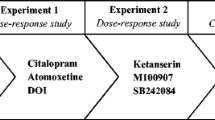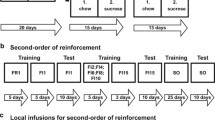Abstract
Schedule-induced polydipsia was used to determine the effects of selective serotonin re-uptake inhibitors on adjunctive water consumption. Polydipsia was induced in food deprived rats by exposure to a fixed time feeding schedule (FT=60 s) for 150 min per day for 22 days. Selected polydipsic rats consumed 3–4 times greater volume of water compared to food deprived control rats. Chronic administration of the selective serotonin re-uptake inhibitors fluoxetine and clomipramine (CMI) at 5 mg/kg per day and fluvoxamine at 10 mg/kg twice a day significantly decreased schedule-induced polydipsia (SIP) on day 15 and throughout the remainder of the study compared to control rats. The noradrenergic re-uptake inhibitor, desipramine (DMI), only decreased SIP behavior on day 1. The neuroleptic, haloperidol (0.03 and 0.1 mg/kg), and the benzodiazepine, diazepam (2.5 mg/kg), failed to alter SIP behavior. Since obsessive-compulsive disorder (OCD) and polydipsic behavior both involve excessive expression of a normal behavior, the polydipsia model may be relevant for the prediction of compounds useful in the treatment of OCD.
Similar content being viewed by others
References
Baxter LR Jr, Phelps ME, Mazziotta JC, Guze BH, Swartz JM, Selin CE (1987) Local cerebral glucose metabolic rates in OCD: A comparison with rates in unipolar and in normal controls. Arch Gen Psychiatry 44:211–218
Blier P, DeMontigny C, Chaput Y (1987) Modifications of the serotonin system by antidepressant treatments: Implications for the therapeutic response in major depression. J Clin Psychopharmacol 7:24s-35s
Blier P, Chaput Y, DeMontigny C (1988) Long-term 5-HT reuptake blockade, but not monoamine oxidase inhibition, decreases the function of terminal 5-HT autoreceptors: an electrophysiological study in the rat brain. Naunyn-Schmiedeberg's Arch Pharmacol 337:246–254
Canon JG, Lippa AS (1977) Effects of clozapine, chlorpromazine and diazepam upon adjunctive and schedule controlled behaviors. Pharmacol. Biochem Behavior 6:581–587
Clifton PG, Barnfield AMC, Phylcox L (1989) A behavioral profile of fluoxetine-induced anorexia. Psychopharmacology 97:89–95
Delgado PL, Goodman WK, Price LH, Heninger GR, Charney DS (1990) Fluvoxamine/pimozide treatment of concurrent Tourette's and obsessive-compulsive disorder. Br J Psychiatry 157:762–765
Falk JL (1971) The nature and determinants of adjunctive behavior. Physiol Behav 6:577–588
Frankel M, Cummings J (1986) Obsessions and compulsions in Tourette's syndrome. Neurology 36:378–382
Goodman WK, McDougle CJ, Price LH, Riddle MA, Pauls DL, Leckman JF (1990a) Beyond the serotonin hypothesis: a role for dopamine in some forms of obsessive-compulsive disorder. J Clin Psychiatry 51:36–43
Goodman WK, Price LH, Delgado DL, Palumbo J, Krystal JH, Nagy LM, Rasmussen SA, Heninger GR, Charney DS (1990b) Specificity of serotonin reuptake inhibitors in the treatment of obsessive-compulsive disorder. Arch Gen Psychiatry 47:577–585
Hussain MZ, Ahad A (1970) Treatment of obsessive-compulsive neurosis. Can Med Assoc J 103[No6]:648
Insel TR (1988) Obsessive-compulsive disorder: new models. Psychopharmacol Bull 24:365–369
Insel TR, Zohar J, Benkelfat C, Murphy D (1990) Serotonin in obsessions, compulsions and the control of aggressive impulses. Ann NY Acad Sci 600:574–586
Kuribara H, Tadokoro S (1980) Effects of psychotropic drugs on FI responding and adjunctive drinking in rats. Pharmacol Biochem Behav 13:657–662
Laplane P, Baulac M, Widlocher D, Dubois B (1984) Pure psychic akinesia with bilateral lesions of the basal ganglia. J Neurol Neurosurg Psychiatry 47:377–385
Lesch KP, Hoh A, Schultze HM, Osterheider M, Muller T (1991) Long term fluoxetine treatment decreases 5-HT1A receptor responsivity in obsessive-compulsive disorder. Psychopharmacology 105:415–425
McDougle CJ, Goodman WK, Price LH, Delgado PL, Krystal JH, Charney DS, Heninger GR (1990) Neuroleptic addition in fluvoxamine-refractory obsessive-compulsive disorder. Am J Psychiatry 147:652–654
Mittleman G, Jones GH, Robbins TW (1988) Effects of diazepam, FG7142 and RO-15-1788 on schedule-induced polydipsia and the temporal control of behavior. Psychopharmacology 94:103–109
O'Regan JB (1970) Treatment of obsessive-compulsive neurosis with haloperidol. Can Med Assoc J 103:167–168
Pauls DL, Towbin KE, Leckman JF (1986) Gilles de la Tourette's syndrome and obsessive-compulsive disorder: evidence supporting an etiological relationship. Arch Gen Psychiatry 43:1180–1182
Pellon R, Blackman DE (1992) Effects of drugs on the temporal distribution of schedule-induced polydipsia in rats. Pharmacol Biochem Behav 43:689–695
Pitman RK (1989) Animal models of compulsive behavior. Biol Psychiatry 26:189–198
Rapoport JL (1991) Recent advances in obsessive-compulsive disorder. Neuropsychopharmacology 5:1–9
Robbins TW, Koob GF (1980) Selective disruption of displacement behavior by lesions of the mesolimbic dopamine system. Nature 285:409–412
Rowland N, Antelman SM, Kocan D (1981) Elevated water intake in rats treated chronically with amphetamine: drinking in excess of need? Appetite 2:51–66
Sanger DJ (1977) Schedule-induced drinking of chlordiazepoxide solutions by rats. Pharmacol Biochem Behav 7:1–6
Sanger DJ, Corfield-Sumner PK (1978) Schedule-induced drinking and thirst: a pharmacological analysis. Pharmacol Biochem Behav 10:471–474
Snodgrass SH, Allen JD (1987) Effect of dopamine agents on schedule-and deprivation-induced drinking in rats. Pharmacol Biochem Behav 27:463–475
Welner SA, DeMontigny C, Desroches J, Desjardins P, Suranyl-Cadotte BE (1989) Autoradiographic quantification of serotonin 1A receptors in rat brain following antidepressant drug treatment. Synapse 4:347–352
Willner P, McGuirk J, Phillips G, Muscat R (1990) Behavioral analysis of the anorectic effects of fluoxetine and fenfluramine. Psychopharmacology 102:273–277
Wise S, Rapoport J (1989) OCD is a basal ganglia dysfunction. In: Rapoport J (ed) Obsessive-compulsive disorder and adolescence. American Psychiatric Press, Washington DC, pp 327–344
Wong DT, Reid LR, Threlkeld PG (1988) Suppression of food intake in rats by fluoxetine: comparison of enantiomers and effects of serotonin antagonists. Pharmacol Biochem Behav 31:475–479
Yadin E, Friedman E, Wagner HB (1991) Spontaneous alternation behavior: an animal model for obsessive-compulsive disorder? Pharmacol Biochem Behav 40:311–315
Author information
Authors and Affiliations
Rights and permissions
About this article
Cite this article
Woods, A., Smith, C., Szewczak, M. et al. Selective serotonin re-uptake inhibitors decrease schedule-induced polydipsia in rats: a potential model for obsessive compulsive disorder. Psychopharmacology 112, 195–198 (1993). https://doi.org/10.1007/BF02244910
Received:
Revised:
Issue Date:
DOI: https://doi.org/10.1007/BF02244910




